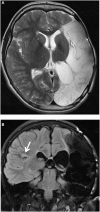Auditory Processing after Early Left Hemisphere Injury: A Case Report
- PMID: 28596753
- PMCID: PMC5442171
- DOI: 10.3389/fneur.2017.00226
Auditory Processing after Early Left Hemisphere Injury: A Case Report
Abstract
Few studies have addressed the long-term outcomes of early brain injury, especially after hemorrhagic stroke. This is the first study to report a case of acquired auditory processing disorder in a 10-year-old child who had a severe left hemorrhagic cerebral infarction at 13 months of age, compromising nearly all of the left temporal lobe. This case, therefore, is an excellent and rare opportunity to investigate the presence of neural plasticity of central auditory system in a developing brain followed severe brain damage. After assuring normal functioning of the peripheral auditory system, a series of behavioral auditory processing tests was applied in dichotic and monaural listening conditions and with verbal and non-verbal stimuli. For all verbal dichotic tasks (dichotic digits, competing words, and sentences tests), good performance on the left ear, especially for Dichotic digits test (100%), and zero performance on the right ear were observed. For monaural low-redundancy tests, the patient also exhibited good performance for auditory figure-ground and time-compressed sentences tests in the left ear. In the right ear, a very poor performance was observed, but slightly better than the same in Dichotic tasks. Impaired performance was also observed in the LiSN test in terms of spatial advantage and, for the Pitch Pattern Sequence test, the only non-verbal test applied, the patient had performance within the normal range in both ears. These results are interpreted taking into consideration the anatomical location of stroke lesion and also the influence of hemispheric specialization for language on auditory processing performance.
Keywords: acquired auditory processing disorder; auditory perception; early brain injury; language reorganization; left hemisphere lesion.
Figures



Similar articles
-
Verbal dichotic listening in developmental stuttering: subgroups with atypical auditory processing.Cogn Behav Neurol. 2004 Dec;17(4):224-32. Cogn Behav Neurol. 2004. PMID: 15622019 Clinical Trial.
-
Investigating the Interaction between Dichotic Deficits and Cognitive Abilities Using the Dichotic Digits difference Test (DDdT) Part 2.J Am Acad Audiol. 2016 Jun;27(6):470-479. doi: 10.3766/jaaa.15085. J Am Acad Audiol. 2016. PMID: 27310405
-
Cognitive effects in dichotic speech testing in elderly persons.Ear Hear. 2001 Apr;22(2):120-9. doi: 10.1097/00003446-200104000-00005. Ear Hear. 2001. PMID: 11324841
-
[Right unilateral auditory agnosia following left lenticular hemorrhage].Rev Neurol (Paris). 1991;147(2):129-37. Rev Neurol (Paris). 1991. PMID: 2028146 Review. French.
-
How to get a left-ear advantage: A technical review of assessing brain asymmetry with dichotic listening.Scand J Psychol. 2018 Feb;59(1):66-73. doi: 10.1111/sjop.12408. Scand J Psychol. 2018. PMID: 29356005 Review.
Cited by
-
Central auditory processing: behavioral and electrophysiological assessment of children and adolescents diagnosed with stroke.Braz J Otorhinolaryngol. 2021 Sep-Oct;87(5):512-520. doi: 10.1016/j.bjorl.2019.10.010. Epub 2019 Dec 9. Braz J Otorhinolaryngol. 2021. PMID: 31983665 Free PMC article.
-
Preserved functional organization of auditory cortex in two individuals missing one temporal lobe from infancy.iScience. 2024 Jul 22;27(9):110548. doi: 10.1016/j.isci.2024.110548. eCollection 2024 Sep 20. iScience. 2024. PMID: 39262782 Free PMC article.
References
-
- American Academy of Audiology. Clinical Practice Guidelines. Diagnosis, Treatment and Management of Children and Adults with Central Auditory Processing Disorder. (2010). Available from: http://www.audiology.org/publications-resources/document-library/central...
-
- Keith RW. SCAN-3: C Tests for Auditory Processing Disorders for Children. San Antonio: Pearson; (2009).
Publication types
LinkOut - more resources
Full Text Sources
Other Literature Sources

